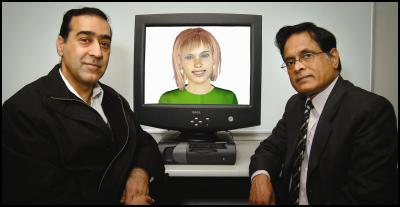Artificial intelligence alive and well
19 January 2005
Artificial intelligence alive and well in a robot named Maria

(centre).
While statistics students at The University of Auckland are taking a break from studies for summer, their new "teacher" can't wait for the new semester to begin.
Maria, an assistant teacher in Statistical Interference, is an unusual individual. She looks to be in her mid-twenties but her age, she says, cannot be computed in human years. With a vocabulary of 203,000 words, a repertoire of 106,000 grammatical rules and 118,000 rules of logical interference, Maria is capable of conversation at quite a complex level.
Maria is a robot, or artificial intelligence entity, created over two years of intense work and study by Shahin Maghsoudi, a PhD student and member of the Artificial Intelligence Group in the Faculty of Science.
As part of his Masters degree in Computer Science, Shahin embarked on a project to create virtual robots which could be used as teaching assistants, helpdesk operators and web-based marketing assistants.
He has already created eight such robots by bringing together a combination of externally available systems and inventing the extra components needed, and says programming robots with skills for human interaction is challenging, but fun.
"When humans interact, they rely on their mutual understanding of a huge body of shared knowledge. On a daily basis, we add to our personal database of knowledge stored in our brain. To interact in a way that seems natural to people, a robot needs to be programmed with a database of this kind," says Shahin.
Maria was created through the joint efforts of Shahin and Dr Tiru Arthanari from the University's School of Business. Dr Arthanari teaches inferential statistical methods as part of a research methods paper. His goal in collaborating with Shahin was to create an electronic "assistant" who would be available 24 hours-a-day and seven days-a-week to answer multiple student questions simultaneously as if they were having one-to-one conversations.
"I know the computer programming aspect, but for Maria to be able to be a good tutor she needed to have all the specialised knowledge and Dr Arthanari provided that material," says Shahin.
Dr Arthanari developed a specialised database, which contained not only the subject expertise and knowledge of where to send the students for ancillary information, but also material relating to principles of effective teaching.
"What we are really doing is creating an illusion. The more care we take about the choice of words, the more effective the interaction will be. A student can easily be put off by abruptness so we needed to create an engaging robot with a polite manner," Dr Arthanari says.
A part of the database is dedicated to student profiles, which can be built either using a "conversation" mode - where students can actually communicate with Maria via the keyboard, or by the student filling in a form when first interacting with the system.
"We're looking at trust-building between the robot and students. The real success will be when students feel that interacting with Maria is just like going to a real teacher who apart from the subject matter knows a little about the students as well," says Dr Arthanari.
Maria is now functional, living on the internet and awaiting a patent. The next step for Shahin and Dr Arthanari is to test Maria and evaluate the effect of her input on the learning of a pilot group of students.
A computer engineer from Iran who migrated to New Zealand in 1990, Shahin's current challenge, as part of his PhD studies in the Computer Sciences Department, is to look at commonsense reasoning and ways of "teaching" the robots to make commonsense judgements.
"The robots are currently programmed for logical reasoning but not for making commonsense decisions. As humans, we engage in commonsense reasoning automatically because of our huge database of information.
"To enable robots to participate in commonsense reasoning, we need a computer programme to gather a huge amount of information."
This includes knowledge taken for granted and could be in the form of statements such as "older people take more time to cross the road" or "birds fly, rocks don't fly", says Shahin.
Shahin is excited about the huge range of potential applications for the robot in teaching any other subject and has already begun collaborating with the Electrical Engineering Department at The University of Arizona to create a virtual teacher of electrical engineering concepts.
To talk with Maria or any of the
other robots visit www.robot-hosting.com
ENDS


 Canterbury Museum: Dinosaur Dolphins Survived In New Zealand Long After Extinction Elsewhere
Canterbury Museum: Dinosaur Dolphins Survived In New Zealand Long After Extinction Elsewhere Retail NZ: Retailers Still Under Pressure At End Of 2024
Retail NZ: Retailers Still Under Pressure At End Of 2024  University of Canterbury: Research Sheds Light On Fire Risk For Canterbury
University of Canterbury: Research Sheds Light On Fire Risk For Canterbury GE Free NZ: Potential $20 Billion Loss In Export Demand Threatens Rural Communities
GE Free NZ: Potential $20 Billion Loss In Export Demand Threatens Rural Communities Science Media Centre: Carbon-storing Construction Materials – Expert Reaction
Science Media Centre: Carbon-storing Construction Materials – Expert Reaction Vegetables New Zealand: New Web-Based Tool Will Help Greenhouse Growers Switch To Geothermal Heating
Vegetables New Zealand: New Web-Based Tool Will Help Greenhouse Growers Switch To Geothermal Heating



